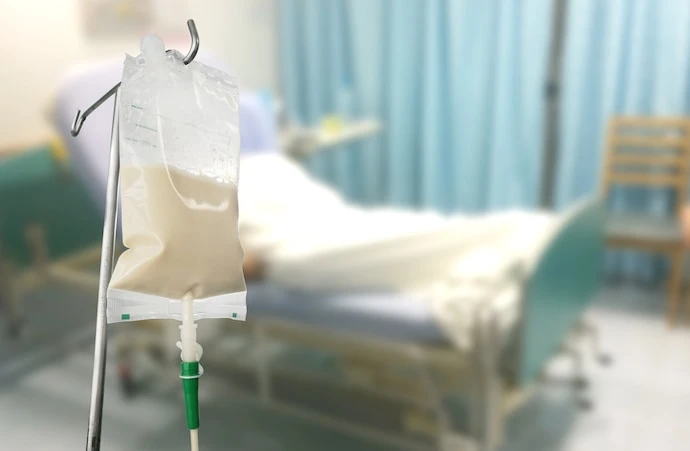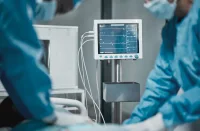In acute critical illness, catabolism leads to muscle wasting, weakness, and difficulty in weaning from ventilation. Low intake of protein, energy, and micronutrients can worsen catabolism, leading to infections, delayed recovery, and increased mortality. Traditionally, it was believed that nutrition could counteract catabolism and improve outcomes. However, recent clinical trials have shown that providing full nutrition in the acute phase can be harmful.
Observational studies have linked cumulative protein and energy deficits with poor outcomes in critical illness. However, these findings might also reflect feeding intolerance as a marker of illness severity. The EPaNIC RCT (2011) was the first to challenge the benefit of early full nutrition, showing that early supplemental parenteral nutrition prolonged ICU dependency and increased complications compared to delayed nutrition.
Subsequent RCTs, such as CALORIES and NUTRIREA-2, found no difference between enteral and parenteral nutrition routes when energy doses were similar. High-dose enteral nutrition was even more harmful in patients with shock. Other RCTs, including EDEN, PermiT, and TARGET, showed that higher doses of enteral nutrition initiated early did not benefit and potentially harmed patients.
The absence of benefits was consistent across various subgroups, including those with high predicted death risk, low BMI, and sepsis. Post hoc analysis of the PermiT RCT found that no baseline nutritional risk markers identified patients who benefited from early enhanced enteral nutrition. Recent RCTs like NUTRIREA-3 demonstrated harm from early high-dose nutrition, regardless of the feeding route.
High protein intake early in critical illness does not provide benefits. The EFFORT Protein RCT, the largest of its kind, found no benefit in administering high protein doses (≥2.2 g/kg/day) compared to usual doses (≤1.2 g/kg/day). High protein intake was linked to prolonged ICU dependency and increased mortality, especially in the most severely ill patients and those with acute kidney injury. Similarly, the Nephro-Protective RCT and secondary analyses of EPaNIC and PEPaNIC attributed harm to higher protein doses from early parenteral nutrition.
A meta-analysis indicated a potential reduction in 28-day mortality with indirect calorimetry but no impact on 90-day mortality or morbidity outcomes. The largest RCT, TICACOS-International, comparing calculated versus measured energy targets, found no benefit from indirect calorimetry-based feeding and was halted due to slow recruitment, questioning the feasibility of routine indirect calorimetry use. These findings may not apply to patients with prolonged critical illness.
In response to recent RCTs, international nutritional guidelines have changed. European guidelines now recommend a less aggressive nutrition approach in the acute phase. While the 2006/2009 guidelines advised starting enteral nutrition within 24 hours and reaching the caloric target (25 kcal/kg/day) within 2-3 days, the 2019 and partially updated 2023 guidelines suggest initiating low-dose enteral nutrition within 48 hours after ICU admission unless contraindicated and advancing toward the energy target within 3-7 days. If enteral nutrition is insufficient, parenteral nutrition is recommended to start between days 4 and 7 instead of within the first 2 days. Regarding protein doses, the previous grade B recommendation of 1.3–1.5 g/kg/day was changed to a grade 0 recommendation, suggesting that 1.3 g/kg/day can be delivered progressively.
The American nutritional guidelines have evolved differently from the European ones over time. While the 2009 American guidelines recommended early initiation of enteral nutrition and no nutrition therapy if enteral nutrition was not feasible, the 2022 guidelines allow for either enteral or parenteral nutrition as primary feeding modalities in the first 7-10 days. They also suggest a lower feeding target of 12-25 kcal/kg/day compared to the 2009 target of 25-30 kcal/kg/day, although this range still includes the full target immediately after ICU admission. The latest guidelines recommend no supplemental parenteral nutrition before day 7 if enteral nutrition is insufficient. For protein, there is a weak recommendation to administer 1.2-2 g protein/kg/day.
Differences between European and American guidelines highlight ongoing uncertainty regarding the optimal nutritional strategy for critically ill patients. The European guidelines recommend below-target feeding for 3-7 days, while American guidelines suggest 7-10 days. This discrepancy reflects concerns about the potential harms of prolonged starvation versus early full nutritional support.
A potential pragmatic feeding strategy for ICU patients is suggested as follows:
Hyperacute Phase (Initial Phase of Critical Illness)
- No nutrition is necessary.
- If spontaneous hypoglycaemia occurs, treat with intravenous glucose.
Post-Stabilisation
- Start enteral nutrition (EN) if possible, considered “early” if initiated within 48 hours.
- If EN is not possible and no non-nutritional energy is provided, consider low-dose glucose.
Progression
- Gradually increase EN toward the target over several days if tolerated.
- If EN remains impossible or insufficient, start parenteral nutrition (PN) between days 4 and 8 and progressively increase toward the target.
Micronutrient Intake
- Avoid full feeding in the first days after ICU admission but ensure sufficient micronutrient intake via maintenance doses of micronutrients, particularly if the patient does not receive sufficient macronutrient intake through oral or enteral routes.
Managing Complications
- If hypophosphatemia occurs upon initiation or increase of feeding, temporarily reduce macronutrient intake while correcting electrolyte abnormalities (especially potassium and phosphate).
- If a patient experiences a new severe insult (e.g., new septic shock) during ICU stay while receiving full feeding, consider temporarily reducing or stopping macronutrient intake.
Special Considerations
- Reasons to delay EN include specific contraindications and high non-nutritional intake from sources like propofol, citrate, or glucose-containing solutions.
- Maintain micronutrient coverage to meet increased basal needs as per ESPEN guidelines.
The recent shift towards restrictive feeding in the acute phase of critical illness could exacerbate micronutrient deficiencies, crucial for various vital functions, including ATP production, antioxidant and immune defences, and enzyme cofactors. These deficiencies often mimic critical illness symptoms and may become apparent during medical nutrition therapy, manifesting as refeeding syndrome. Refeeding syndrome can lead to severe complications such as life-threatening arrhythmias and muscle weakness due to the increased need and uptake of micronutrients and electrolytes.
Cautious build-up of nutrition in patients at risk of refeeding syndrome is advised, although studies have not confirmed if progressive nutrition therapy or adequate micronutrient and electrolyte administration can reduce refeeding risk. Maintenance doses of micronutrients are recommended, though ideal doses are unclear, and plasma concentrations are unreliable due to inflammation-related redistribution.
Future RCTs should explore interventions beyond the acute phase and into the recovery period. Validated tools are needed to monitor actual energy, protein, and micronutrient requirements, aiming to minimise over- and underfeeding. Despite the risk of micronutrient deficiencies and refeeding syndrome with delayed nutrition initiation, it is advisable to ensure coverage of basal micronutrient needs in all critically ill patients.
Source: Intensive Care Medicine
Image Credit: iStock










